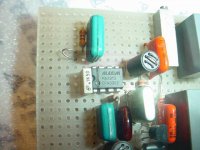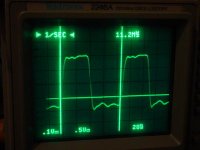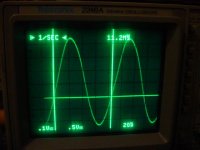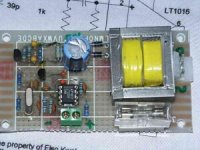First of all I want to thank Elso for sharing his project.
Of course my implementation doesn't claim to be state of the art, since it's made on veroboard without a great experience on HF layout, but I thought it could be nice to share my building experience and to receive a feedback from who has built it (and from Elso, of course!).
I borrowed (again 😉 ) a digicam and took a few shots.
Pic 1: the assembly
Of course my implementation doesn't claim to be state of the art, since it's made on veroboard without a great experience on HF layout, but I thought it could be nice to share my building experience and to receive a feedback from who has built it (and from Elso, of course!).
I borrowed (again 😉 ) a digicam and took a few shots.
Pic 1: the assembly
Attachments
Last pic.. voltage at source of Jfet.. can someone explain why the waveform has a bump?
Should I try swapping the fet with another model or I'd better change the value of the source resistor (or what else)?
Cheers
Andrea / waiting for comments
Should I try swapping the fet with another model or I'd better change the value of the source resistor (or what else)?
Cheers
Andrea / waiting for comments
Attachments
to bump or not to bump...
While taking further measurements to get rid of this bump I noticed the extreme sensitivity of the node connected to the source to capacitive loading to ground... I should have realized that before (the cap to gnd is only 39 pF !) but all became clear whan I left out the cap and connected my oscilloscope probe (10x)... I got a nearly perfect sinewave!
Then connected the same probe to the output and.. nothing! The oscillator had stopped working...
Conclusion: the bump is probably due to the capacitance of the probe
Cheers
Andrea / who enjoys learning from building circuits😀
While taking further measurements to get rid of this bump I noticed the extreme sensitivity of the node connected to the source to capacitive loading to ground... I should have realized that before (the cap to gnd is only 39 pF !) but all became clear whan I left out the cap and connected my oscilloscope probe (10x)... I got a nearly perfect sinewave!
Then connected the same probe to the output and.. nothing! The oscillator had stopped working...
Conclusion: the bump is probably due to the capacitance of the probe

Cheers
Andrea / who enjoys learning from building circuits😀
Kwak-clock
Hello Andrea,
You got decent squarewaves indicating a working clock. The "bumps" you mentioned are not important at all.
One of my first faults was connecting a 1x probe to a CMOS oscillator as it stopped working immediately. Yes ordinary probes have capacitance too.
I am using other kind of parts but I have seen pictures of the KC with all kinds of parts. Here is another one (not by me)😎
Hello Andrea,
You got decent squarewaves indicating a working clock. The "bumps" you mentioned are not important at all.
One of my first faults was connecting a 1x probe to a CMOS oscillator as it stopped working immediately. Yes ordinary probes have capacitance too.
I am using other kind of parts but I have seen pictures of the KC with all kinds of parts. Here is another one (not by me)😎
Attachments
Hi,
I'm just finishing mine on vero board ,too.Had put it together week ago but waited for J309 to arrive (thanks Elso for J309,i just recived it a couple of hours ago).
I'm just not qiute sure how the pin-out of J309 is and how to put it into circuit.
I assume drain goes to + supply,source to crystal and gate to AD8651 and to ground trought 1Kohm resistor.
Is it correct??
Bartek
I'm just finishing mine on vero board ,too.Had put it together week ago but waited for J309 to arrive (thanks Elso for J309,i just recived it a couple of hours ago).
I'm just not qiute sure how the pin-out of J309 is and how to put it into circuit.
I assume drain goes to + supply,source to crystal and gate to AD8651 and to ground trought 1Kohm resistor.
Is it correct??
Bartek
Pinout
Hello Bartek,
See this site for pinouts by Yeo :http://www.diyparadise.com/clock.html
It is Drain to supply, Source to 1k and Gate to crystal.😎
zygibajt said:Hi,
I'm just finishing mine on vero board ,too.Had put it together week ago but waited for J309 to arrive (thanks Elso for J309,i just recived it a couple of hours ago).
I'm just not qiute sure how the pin-out of J309 is and how to put it into circuit.
I assume drain goes to + supply,source to crystal and gate to AD8651 and to ground trought 1Kohm resistor.
Is it correct??
Bartek
Hello Bartek,
See this site for pinouts by Yeo :http://www.diyparadise.com/clock.html
It is Drain to supply, Source to 1k and Gate to crystal.😎
Thanks a lot.
Maybe i will put some photos tomorrow if I get the camera.
For now I will use it with CDP supply but will build separate this coming week.
Bartek
Maybe i will put some photos tomorrow if I get the camera.
For now I will use it with CDP supply but will build separate this coming week.
Bartek
Re: Kwak-clock
Hello Elso,
do you think that a separate power supply is worthwhile or i can sticjk with the one of the CDP?
Cheers
Andrea
Elso Kwak said:Hello Andrea,
You got decent squarewaves indicating a working clock. The "bumps" you mentioned are not important at all.
One of my first faults was connecting a 1x probe to a CMOS oscillator as it stopped working immediately. Yes ordinary probes have capacitance too.
I am using other kind of parts but I have seen pictures of the KC with all kinds of parts. Here is another one (not by me)😎
Hello Elso,
do you think that a separate power supply is worthwhile or i can sticjk with the one of the CDP?
Cheers
Andrea
Re: Re: Kwak-clock
Hi Andrea,
I tried both but found the raw supply of the player giving better sound. This is a rather unexpected result but I can live with that. Just follow the instructions I have sent you.
😎
Andypairo said:
Hello Elso,
do you think that a separate power supply is worthwhile or i can sticjk with the one of the CDP?
Cheers
Andrea
Hi Andrea,
I tried both but found the raw supply of the player giving better sound. This is a rather unexpected result but I can live with that. Just follow the instructions I have sent you.
😎
I Just wondering..
HI. Elso Kwak
I wanna make your KWAK-CLOCK-7
But I wanna use different PSU
I think high quality SHUNT REGULATOR will be fine
So I have to design SHUNT REG for KC7
But I dunno how much current needed for Oscillation(J309 and etc..) section. For AD8561(AD8611) section I can refer to Datasheet 😕
Would you tell me how much current needed at oscillation section(J309) 😉
Sorry for poor English
Merry Christmas !!
HI. Elso Kwak
I wanna make your KWAK-CLOCK-7
But I wanna use different PSU
I think high quality SHUNT REGULATOR will be fine
So I have to design SHUNT REG for KC7
But I dunno how much current needed for Oscillation(J309 and etc..) section. For AD8561(AD8611) section I can refer to Datasheet 😕
Would you tell me how much current needed at oscillation section(J309) 😉
Sorry for poor English
Merry Christmas !!
Hello,
thanks to Elso for sharing his knowledge.
I am looking around for the components, j309 seems to be difficult to buy. J310 is no problem here, so can I use this without
any problems?
Can anyone please name the thread where Elso postet the schematic for Elso Kwak 7, I downloaded the schematic, but missed to save the url. I wouzld like to link it at my website.
Thanks to all
Christian.
thanks to Elso for sharing his knowledge.
I am looking around for the components, j309 seems to be difficult to buy. J310 is no problem here, so can I use this without
any problems?
Can anyone please name the thread where Elso postet the schematic for Elso Kwak 7, I downloaded the schematic, but missed to save the url. I wouzld like to link it at my website.
Thanks to all
Christian.
- Status
- Not open for further replies.
- Home
- Source & Line
- Digital Source
- My Kwack clock implementation






